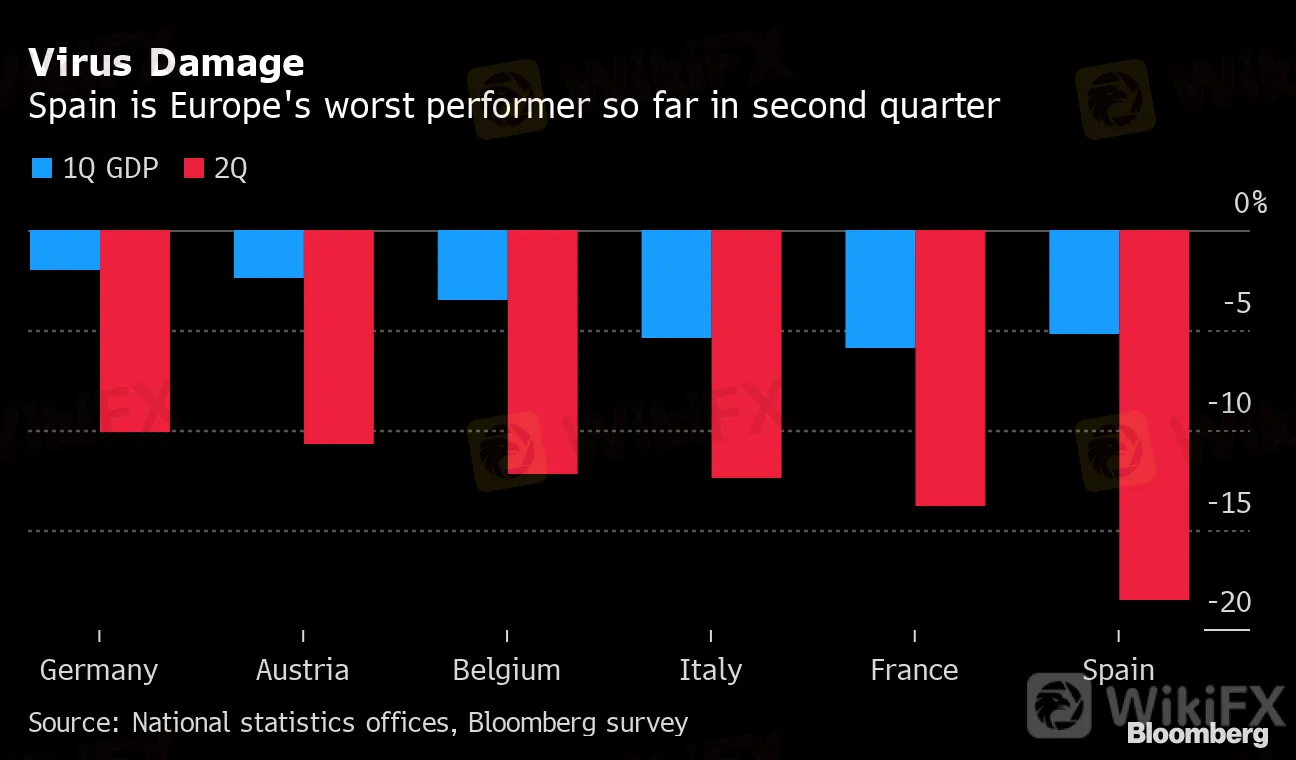简体中文
繁體中文
English
Pусский
日本語
ภาษาไทย
Tiếng Việt
Bahasa Indonesia
Español
हिन्दी
Filippiiniläinen
Français
Deutsch
Português
Türkçe
한국어
العربية
Virus Plunges Euro-Area Into Deep Recession
Abstract:The coronavirus pandemic sent the euro-area economy into the deepest recession on record in the second quarter, taking output back to levels not seen since early 2005.
The coronavirus pandemic sent the euro-area economy into the deepest recession on record in the second quarter, taking output back to levels not seen since early 2005.
While indicators show a rebound is already underway, the 12.1% plunge in the 19-member region and mounting concerns about new flare-up in infections point to a long recovery that may leave lasting scars in its wake.
Spain took the biggest hit, shrinking 18.5%, while French and Italian output also dropped by double digits. The declines reflect the effect of strict quarantines measures on businesses and consumer spending, and a slump in tourism in some countries.
Virus Damage
Spain is Europe's worst performer so far in second quarter
Source: National statistics offices, Bloomberg survey

The health crisis was most severe in the regions least economically resilient members, leaving them with little firepower to support households and businesses. That forced European Union leaders to overcome longstanding differences on joint borrowing and agree on a historic 750 billion-euro ($889 billion) rescue fund this month.
National governments have already stretched their budgets to deal with the crisis, and the European Central Bank launched a 1.35 trillion-euro bond emergency program to contain the economic shock.
“I don‘t think anybody really realistically should think that levels of GDP by the end of 2021 will be back at the pre-crisis levels,” Erik Nielsen, UniCredit Group chief economist, told Bloomberg TV’s Francine Lacqua and Tom Keene. “Monetary policy will keep the pedal to the metal.”
The euro was trading little changed at $1.1843 as of 2:07 p.m. in Frankfurt. It had earlier breached $1.19.
The ECB‘s actions have particularly targeted southern Europe after bond yields in Italy spiked early in the crisis because of investor worries that huge health spending could cripple the the country’s already-weak finances.
While that economy‘s second-quarter slump was less than in Spain or France, it’s in a particularly vulnerable position because of its debt burden and sluggish long-term growth.
Overall, the rebound in Europe is under threat from a surge in new outbreaks thats emerging across the globe. Governments are reluctant to impose strict national lockdowns, but economies could suffer anyway if fear of infection alters consumer behavior or stops people going to stores, bars and restaurants.
That puts countries such as Italy, Spain and Greece -- all of which have huge tourism sectors -- under the spotlight. Spains already bad summer season took a turn for the worse last weekend when the U.K. announced that holidaymakers returning from the country would have to quarantine because of an uptick in coronavirus cases in some regions.
What Bloomberg‘s Economists’ Say...
“The big question is how far the recovery has to run. High-frequency indicators suggest the pace is now slowing and we expect a combination of ongoing social distancing rules, spending caution and weak external demand to act as a ceiling on activity for the rest of this year. And the main risk -- a second wave of infections -- looks closer to crystalizing.”
-- Jamie Rush, chief European economist. Read his full REACT.
The other major risk is long-term damage to the labor market. Government support programs in Europe prevented unemployment from surging as it has in the U.S., but they may only be delaying rather than preventing devastating layoffs.
With the outlook so uncertain, some expect the ECB to increase its bond-purchase program again before the end of the year to revive growth and bring inflation closer to its target of just under 2%. Data Friday showed euro-zone consumer prices grew 0.4% in July.
Euro-area unemployment is already creeping higher, as companies across the continent respond to weak demand and a dramatically changed global backdrop, particularly for travel and tourism.
Airlines have announced thousands of job cuts, while Frances Airbus SE could eliminate 11% of its global payroll. Its plans to reduce headcount in Spain -- where unemployment is already high -- sparked demonstrations.
High frequency data and surveys show that activity has bounced back from its trough in April and May. The sustainability of that is in question, however, particularly amid growing concern about fresh virus outbreaks.
Germany, where the economy shrank 10% in the second quarter, has already sounded the alarm over rising infection rates.
“We observed a slight recovery in sentiment and certain soft indicators. So we can say in Europe we have the first signs of recovery,” ECB Governing Council member Yannis Stournaras said in a Bloomberg interview this week. “Still, the risks are on the downside.”
| Read More: |
|---|
|
— With assistance by William Horobin, Jeannette Neumann, Harumi Ichikura, Kristian Siedenburg, and Adeola Eribake
(Updates with size of the economy in first paragraph.)
Disclaimer:
The views in this article only represent the author's personal views, and do not constitute investment advice on this platform. This platform does not guarantee the accuracy, completeness and timeliness of the information in the article, and will not be liable for any loss caused by the use of or reliance on the information in the article.
WikiFX Broker
Latest News
SQUARED FINANCIAL: Your Friend or Foe?
Big News! UK 30-Year Bond Yields Soar to 25-Year High!
High-Potential Investments: Top 10 Stocks to Watch in 2025
Why Is Nvidia Making Headlines Everywhere Today?
Discover How Your Trading Personality Shapes Success
US Dollar Insights: Key FX Trends You Need to Know
FINRA Charges UBS $1.1 Million for a Decade of False Trade Confirmations
BI Apprehends Japanese Scam Leader in Manila
Bitcoin in 2025: The Opportunities and Challenges Ahead
Join the Event & Level Up Your Forex Journey
Currency Calculator






